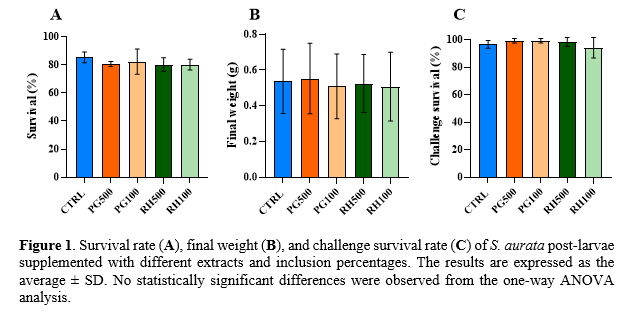IN VITRO AND IN VIVO EFFECTS OF BIOACTIVES FROM TERRESTRIAL AND MARINE BY-PRODUCTS AND LOW VALUE BIOMASS IN GILTHEAD SEABREAM Sparus aurata POST-LARVAE
Introduction
In 2022, an estimated 1.05 billion tonnes of food were wasted globally, with fruits and vegetables being the most misused types (UNEP, 2024). Therefore, the recovery and valorisation of bioactive substances from those low value biomass and by-products is a challenging and important task. N ot only land-based by-products have potential, since marine by-products have evolved over time from being considered as a secondary material to an opportunity for value-added products. Those bioactives have potential for boosting fish mucosal health and endogenous antioxidant capacity, and specifically proactively reinforcing the health status implied in the defence against pathogen and environmental challenges during developmental stages, such as post-larvae stages. To assess the potential of these eco-innovative functional by-products and value-added bioactives as fish health boosters, it is essential to previously characterize and evaluate their potential antioxidant/immunomodulatory activity.
Thus, the objective of this study was to evaluate , through sequential in vitro and in vivo experiments, the antioxidant and immunomodulatory activities of terrestrial and marine by-product extracts in gilthead seabream (Sparus aurata) post-larvae.
Material and Methods
Nine extracts from by-products and low value biomass were tested, 4 of terrestrial origin and 5 of marine origin. Those of terrestrial origin were 2 extracts of pomegranate, one rich in punicalagin and the other rich in ellagic acid (PG and EA, respectively), an extract rich in citrus flavonoids (CF) and a grape seed extract (GSE). The marine ones were extracts of Rhodomonas lens (RH), Osmundea pinnatifida (OS), Gracilaria sp. (GR), Desmodesmus sp. (DE) and Dyctiota sp. (DY). Extracts phenolic compounds and flavonoids content, as well as their antioxidant activity by ABTS and FRAPs activities were assayed . A n in vitro screening of the extracts antioxidant and immunomodulatory activities was performed using seabream head kidney leukocytes. Specifically , viability, respiratory burst, peroxidase content and phagocytic capacity of the leukocytes were analyzed. Based on the results obtained on the in vitro asssays, two extracts were chosen, one of terrestrial origin and the other of marine origin (PG and RH) to be tested in vivo at two dietary dosages in seabream post-larvae. This experiment (CEEA_ULPGC 33-2023) was carried out from 49 days post- hatch (dph ) to 90 dph , testing each diet in quadruplicate tanks with 600 larvae/tank. After the feeding period, a stress challenge was performed by exposing 30 larvae from each tank to air for 2 minutes and observing their recovery for 24h. The analyses of this experiment are currently in progress.
Results
Regarding the in vitro results, different trends were observed depending on the origin of the extracts (i.e. terrestrial or marine). In the case of terrestrial extracts, a higher content of phenolic compounds and flavonoids was observed (p-value < 0.0001), which resulted in a higher antioxidant capacity (p-value < 0.0001) compared to marine extracts. Among the terrestrials, GSE presented the highest levels in phenolics compounds and flavonoids (p-value < 0.0001), which was related to a higher antioxidant capacity according to ABTS (p-value < 0.0001) but not by FRAPS, where the best results were obtained with pomegranate extracts (p -value = 0.0003) . This may be due to the dependence of the antioxidative capacity of the extracts on their structure, presence of hydroxyl groups or their glycosylation (Parcheta et al., 2021) rather than their total content. On the other hand, a more direct relationship between phenolic compounds and flavonoids with the results in ABTS and FRAPs was observed in marine extracts, with the best candidate being RH. All compounds, except RH and OS, presented an inverse relationship between dose and cell viability. In terms of immunomodulatory activity, the marine compounds showed generally higher activity, possibly caused by the presence of Marine Sulphated Polysaccharides (MSP) (Petit et al. , 2024).
Considering the above, PG and RH were chosen as candidates for the in vivo assay. The results obtained so far show that supplementation with these extracts did not affect either growth or survival of seabream post-larvae. In addition, survival to a stressor such as air exposure was not affected either, with all groups showing values above 90%.
The rest of the analyses: histology, RNA sequencing and antioxidant enzymes activity, parameters that will provide valuable information, are currently in progress.
Bibliography
United Nations Environment Programme (UNEP). (2024). Food Waste Index Report 2024
Parcheta, M., Świsłocka, R., Orzechowska, S., Akimowicz, M., Choińska, R., & Lewandowski, W. (2021). Recent developments in effective antioxidants: The structure and antioxidant properties. Materials, 14(8), 1984.
Petit, J., van den Brink, E., Collén, P. N., Haenen, O. L., Schrama, J., & Wiegertjes, G. F. (2024). Green and red macroalgae extracts show antibacterial effects and induce innate immune responses in Nile tilapia and rainbow trout in vitro . Comparative Immunology Reports, 6, 200128.
Acknowledgments
Project PID2021-122474OB-I00 funded by MCIN/AEI/ 10.13039/501100011033 and by ERDF/EU. Luis Molina is supported by the Grant PRE2022-103656 funded by MICIU/AEI/10.13039/501100011033 and by “ESF+”. Silvia Torrecillas is financed by a Ramón y Cajal fellowship (RYC2021-031414-I) funded by MICIU/AEI/10.13039/501100011033 and by “European Union NextGenerationEU/PRTR.
